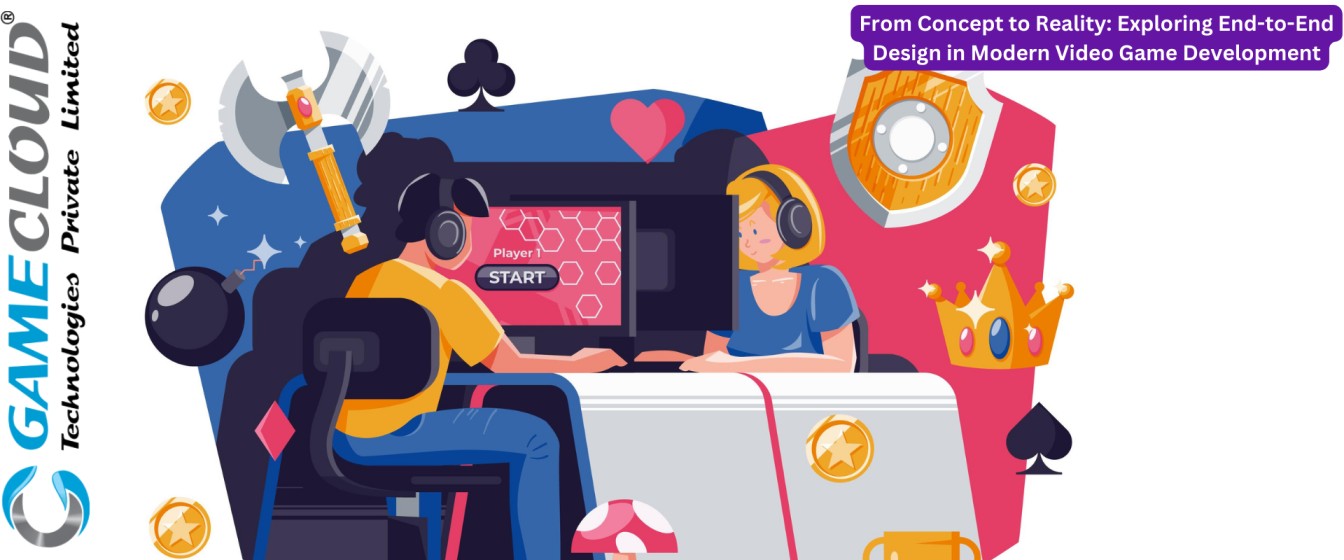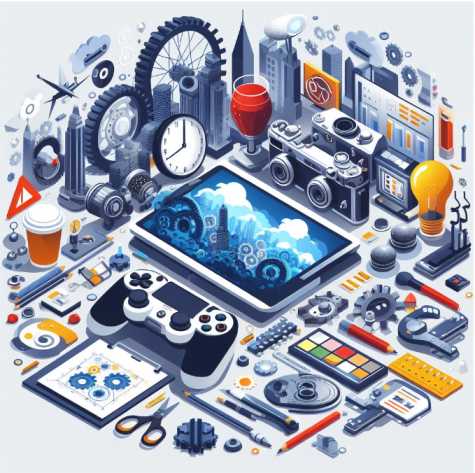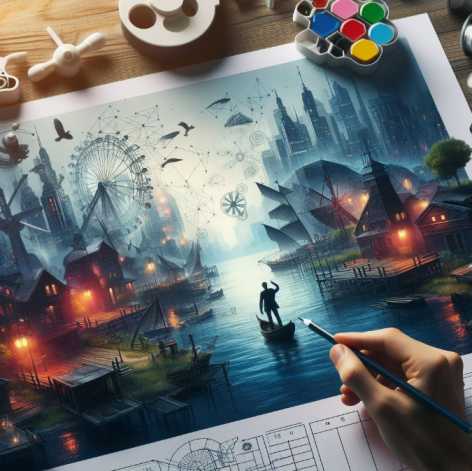
The world of video game development has evolved significantly over the years, with advancements in technology and innovative design approaches transforming the way games are created. From concept to reality, the journey of game development involves a multitude of stages, each requiring meticulous planning, execution, and collaboration among various stakeholders. This blog post delves into the intricacies of end-to-end design in modern video game development, highlighting the current landscape, futuristic trends, and predictions that are shaping the industry. We will explore the key aspects of game development, including concept creation, design, programming, art, sound, and quality assurance, as well as the role of emerging technologies like Metaverse, Blockchain, NFT, AR, VR, and AI in shaping the future of gaming.
Common Challenges Faced During the Game Concept Creation and Testing Process
The game development process involves several stages, including concept creation and testing. These stages are crucial in determining the success of a game. However, they also come with their own set of challenges that game developers and testers must overcome. Here are some common challenges faced during the game concept creation and testing process:
- Concept Creation Challenges
- Defining the Game’s Core Mechanics: One of the biggest challenges in game concept creation is defining the game’s core mechanics. This involves identifying the game’s unique features, gameplay mechanics, and user interface. It requires a deep understanding of the target audience and their preferences.
- Balancing Gameplay and Storyline: Another challenge is balancing the gameplay and storyline. This involves ensuring that the game’s narrative is engaging and the gameplay is enjoyable. It requires a delicate balance between the two elements.
- Ensuring Originality and Uniqueness: Game developers face the challenge of creating a unique and original game concept that stands out from the competition. This involves conducting thorough market research and identifying gaps in the market.
- Managing Stakeholder Expectations: Game developers must manage stakeholder expectations, including those of investors, publishers, and the development team. This involves setting clear goals and objectives and ensuring that everyone is aligned.
- Testing Challenges
- Ensuring Cross-Platform Compatibility: One of the biggest challenges in game testing is ensuring cross-platform compatibility. This involves testing the game on different hardware combinations, devices, operating systems, and browsers to ensure that it functions smoothly.
- Managing Complexity: Another challenge is managing complexity. This involves identifying and addressing complex issues, such as latency, connectivity, and performance, to ensure a seamless gaming experience.

- Ensuring Security and Data Protection: Game testers face the challenge of ensuring security and data protection. This involves identifying and addressing vulnerabilities, as well as ensuring that player data is protected.
- Managing User Expectations: Game testers must manage user expectations by ensuring that the game meets the expected standards of quality, performance, and user experience.
- Additional Challenges
- Managing Budget and Resources: Game developers and testers face the challenge of managing budget and resources. This involves allocating resources effectively and ensuring that the game is developed within the allocated budget.
- Managing Time Constraints: Another challenge is managing time constraints. This involves ensuring that the game is developed and tested within the allocated time frame.
- Staying Up-to-Date with Industry Trends: Game developers and testers must stay up-to-date with industry trends and advancements in technology to ensure that their games remain competitive.
The game concept creation and testing process involves several challenges that game developers and testers must overcome. These challenges include defining the game’s core mechanics, balancing gameplay and storyline, ensuring originality and uniqueness, managing stakeholder expectations, ensuring cross-platform compatibility, managing complexity, ensuring security and data protection, managing user expectations, managing budget and resources, managing time constraints, and staying up-to-date with industry trends.
The Current Landscape of Game Development
The gaming industry has experienced remarkable growth in recent years, with an estimated value of USD 245.10 billion in 2023 and forecasted to reach USD 376.08 billion by 2028, following a Compound Annual Growth Rate (CAGR) of 8.94% during the forecasted period of 2023-2028. This growth can be attributed to the increasing adoption of current trends in game development, such as Augmented Reality (AR) & Virtual Reality (VR), Blockchain, Metaverse, cloud gaming, and the widespread use of smartphones.
The Metaverse, in particular, is expected to play a significant role in shaping the future of gaming. The Global Metaverse in Gaming Market is estimated to expand from USD 36.81 billion in 2022 to USD 710.21 billion at a CAGR value of 38.2% from 2022 to 2027. This rapid growth is driven by the increasing demand for immersive and interactive gaming experiences, as well as the potential for the Metaverse to integrate with the real world in various ways.
Cloud gaming is another significant trend in the gaming industry. The Cloud Gaming Market size is expected to reach USD 3.92 billion in 2024 and grow at a CAGR of 44.91% to reach USD 25.02 billion by 2029. This growth is propelled by advancements in 5G and broadband, reducing latency and offering faster speeds, making digital gaming more accessible without the need for powerful hardware. The widespread use of smartphones also contributes to the growth of the gaming industry. With the increasing adoption of mobile gaming, the global mobile gaming market is expected to reach USD 128.5 billion by 2025, growing at a CAGR of 13.3% from 2020 to 2025.

Designing the Game: Concept to Reality
The journey of transforming a game concept into a reality is a multifaceted process that involves several key stages, each with its own unique challenges and considerations. Let’s delve deeper into the intricacies of each stage:
- Concept Creation
The game development process begins with the creation of a concept, which involves defining the game’s core mechanics, storyline, and overall vision. This stage is crucial in setting the foundation for the entire project, as it outlines the game’s objectives, target audience, and gameplay elements. Game designers are responsible for crafting the initial concept, which includes:
- Defining the game’s genre, theme, and setting
- Developing the storyline and characters
- Determining the core gameplay mechanics and objectives
- Identifying the target audience and their preferences
- Game Design
The design phase involves creating levels, stages, or missions within a game. It’s a more profound and intricate process that involves crafting experiences, rather than just placing objects, enemies, or environmental artwork. Game designers work closely with other team members, such as artists and programmers, to bring the concept to life. Key aspects of the design phase include:
- Detailed level design, including layout, obstacles, and challenges
- User interface (UI) design, ensuring intuitive and engaging interactions
- Balancing gameplay elements for optimal challenge and enjoyment
- Iterative testing and refinement based on feedback and playtesting
- Programming
The programming of the game is handled by one or more game programmers. They develop prototypes to test ideas, many of which may never make it into the final game. The programmers incorporate new features demanded by the game design and fix any bugs introduced during the development process. Even if an off-the-shelf game engine is used, a great deal of programming is required to customise almost every game. Key programming tasks include:
- Implementing core gameplay mechanics and systems
- Integrating art assets and sound effects
- Optimizing performance and addressing technical issues
- Ensuring cross-platform compatibility and functionality
- Art and Sound
The art and sound departments work together to create visually stunning and immersive environments. The art treatment may evolve, and the backstory may change during development. Artists are responsible for creating:
- 2D and 3D assets, such as characters, environments, and props
- Animations that bring the game world to life
- Visual effects that enhance the overall aesthetic
- User interface elements that are both functional and visually appealing
Sound engineers and composers collaborate to develop:
- Ambient sounds and sound effects that enhance the gameplay experience
- Music that sets the tone and mood for different game environments and situations
- Voice acting and dialogue that adds depth to the characters and storyline

- Quality Assurance
Quality assurance ensures that the game meets the required standards before its release. Game testers perform various crucial duties, including identifying technical and creative issues that might have an adverse impact on the user experience. Key aspects of quality assurance include:
- Comprehensive testing across various platforms and devices
- Identifying and reporting bugs, glitches, and performance issues
- Providing feedback on gameplay, user experience, and overall enjoyment
- Collaborating with developers to address issues and implement fixes
The journey from concept to reality in modern video game development is a complex and multifaceted process that requires collaboration among various disciplines, including game design, programming, art, sound, and quality assurance. Each stage of the process is crucial in ensuring that the final product meets the expected standards of quality, performance, and user experience.
Emerging Technologies Shaping the Future of Game Development
The gaming industry is on the cusp of a technological revolution, with cutting-edge innovations poised to transform the way we create, interact with, and experience games. From the immersive potential of the Metaverse to the secure and transparent transactions enabled by Blockchain, these emerging technologies are set to redefine the boundaries of gaming. Let’s delve deeper into the key innovations that are shaping the future of game development:
- Metaverse: The Metaverse, a convergence of virtual, augmented, and physical realities, is set to revolutionise the gaming landscape. This interconnected virtual world promises seamless transitions between digital and physical spaces, allowing players to engage in immersive gaming experiences like never before. Game developers are exploring the Metaverse’s potential to create shared virtual environments where players can socialise, collaborate, and compete in real-time, regardless of their physical location.
- Blockchain and NFTs: Blockchain technology is making inroads into the gaming industry, offering new possibilities for secure and transparent transactions. Non-Fungible Tokens (NFTs) are digital assets built on blockchain networks that are unique, verifiable, and tradable. In gaming, NFTs can represent in-game items, characters, or even entire virtual worlds, allowing players to own and trade these assets. This opens up new revenue streams for game developers and empowers players to have a stake in the virtual economies they participate in.
- Augmented Reality (AR) and Virtual Reality (VR): AR and VR technologies have already made significant strides in the gaming industry, and their potential is set to expand further in the coming years. AR games blend digital elements with the real world, creating immersive experiences that seamlessly integrate with the player’s surroundings. VR, on the other hand, fully immerses players in simulated 3D environments, offering a level of realism and interactivity that was previously unimaginable. As these technologies continue to advance, game developers can expect to create even more captivating and immersive gaming experiences that push the boundaries of what’s possible.
- Artificial Intelligence (AI): AI is making significant strides in game development, revolutionising everything from character behaviour to game design. Adaptive AI algorithms can create non-player characters (NPCs) with more human-like behaviours and dynamics, responding to player interactions in real-time. AI is also being used to generate game content, from intricate landscapes to engaging storylines, reducing the manual labour required in the development process. Moreover, AI can be leveraged for game testing and quality assurance, identifying potential issues and bugs before the game’s release.
- Cloud Gaming: Cloud gaming, also known as gaming as a service (GaaS), is transforming the way players access and experience games. By streaming games from remote servers, players can enjoy high-quality gaming experiences without the need for powerful hardware or lengthy downloads. Cloud gaming also enables developers to deliver updates and patches more easily, as well as to scale their games to accommodate more users and regions. As internet connectivity and streaming technology continue to improve, cloud gaming is poised to reshape the gaming industry and provide new opportunities for gamers worldwide.
Post-Production in Game Development: Polishing and Presenting the Game
Post-production in game development is a crucial phase that occurs after the final version of the game is released. This stage focuses on refining the game, addressing any remaining issues, and preparing it for launch to players. Let’s delve deeper into the intricacies of post-production in game development:
- Polishing the Game: During post-production, game developers focus on polishing the game to ensure it meets the desired standards of quality, performance, and user experience. This involves fine-tuning various aspects of the game, including:
- Bug-Fixing: Despite rigorous testing during development, most games still contain minor bugs at launch. The post-production stage is dedicated to identifying and resolving these bugs to enhance the overall gameplay experience.
- Optimization: Developers work on optimizing the game’s performance, ensuring smooth gameplay and efficient resource utilization across different platforms and devices.
- User Experience Enhancements: Feedback from testers and early players is incorporated to improve the overall user experience, addressing issues related to controls, interface, and gameplay mechanics.
- Presenting the Game to Players: Post-production also involves preparing the game for its official release and presenting it to players. Depending on the business model and development strategy, this phase can vary:
- Continuous Updates: Some games adopt a live service model, continuously releasing new features, levels, and accessories to keep players engaged and invested in the game.
- Final Release: Other games opt for a traditional release model, where all content is finalized and released in one big launch. This approach allows developers to focus on delivering a complete and polished gaming experience from the start.
- Game Maintenance: A significant aspect of post-production is game maintenance, which involves ongoing support and updates to ensure the game remains relevant and enjoyable for players. Key activities during game maintenance include:
- Bug Monitoring and Fixing: Developers continue to monitor and address any new bugs or issues that arise post-launch, ensuring a smooth and bug-free gaming experience for players.
- Content Updates: Regular software updates are released to introduce new content, features, and improvements to the game, keeping players engaged and excited about the gaming experience.
- Community Engagement: Developers interact with the player community, gather feedback, and respond to player suggestions to foster a positive and engaging gaming environment.
Post-production in game development is a critical phase that focuses on refining, enhancing, and presenting the game to players. By addressing bugs, optimizing performance, enhancing user experience, and maintaining the game post-launch, developers can ensure a successful and engaging gaming experience for players.
LolzSoft Leading From the Front
LolzSoft, a sub-brand of GameCloud Technologies Pvt Ltd, is at the forefront of innovative video game development in the B2B field, specializing in creating immersive gaming experiences with a creative twist. Emerging from the renowned gaming giant GameCloud Technologies, LolzSoft continues the tradition of excellence by crafting games that not only entertain but also redefine the gaming landscape. With a mission to create games that bring joy, laughter, and education to people’s lives, LolzSoft stands out for its commitment to delivering unique and engaging gaming experiences that resonate with players worldwide. Through their cutting-edge video design and development, LolzSoft is setting new standards in the industry, showcasing a blend of creativity, technology, and player-centric focus that positions them as a leader in the evolving gaming landscape.
Conclusion
In conclusion, the journey of game development from concept to reality is a complex and multifaceted process that involves collaboration among various stakeholders. The current landscape of game development is marked by the increasing adoption of innovative design approaches and emerging technologies, which are expected to shape the future of gaming. As the industry continues to evolve, it is crucial for game developers to stay at the forefront of innovation, embracing new technologies and design approaches to create immersive and engaging gaming experiences.
